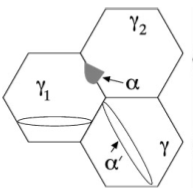

Many aspects of the crystallographic texture which develops when austenite transforms into martensite or bainite are well-established because the process by which the parent lattice is transformed into that of the product is mathematically defined. This is not the case when the ferrite forms by a reconstructive mechanism. The allotriomorphic ferrite nucleates heterogeneously at austenite grain boundaries, and although a reproducible, low-energy orientation relationship is expected to exist between the ferrite and one of the austenite grains with which it is in contact, there are reports that the ferrite can simultaneously adopt this orientation with more than one austenite grain. We examine this possibility using crystallographic theory in order to assess the probability of such events as a function of the strength of the texture within the austenite prior to its transformation.
Materials Science and Technology 2009, DOI: 10.1179/174328408X365793

| MAP_STEEL_FERRITE_TEXTURE | PROGRAM:Calculates probability of an allotriomorph of ferrite which nucleates at an austenite grain boundary having a good-fit orientation relationship with both of the adjacent austenite grain, and the resulting crystallographic texture. |
| Coalesced | Foam | TWIP | FSW | 3D |
| Texture | Properties | Silicon | Synchrotron | Models |
| Neural Networks | Creep | Mechanicallly Alloyed | Theses | Retained Austenite |
| PT Group Home | Materials Algorithms |